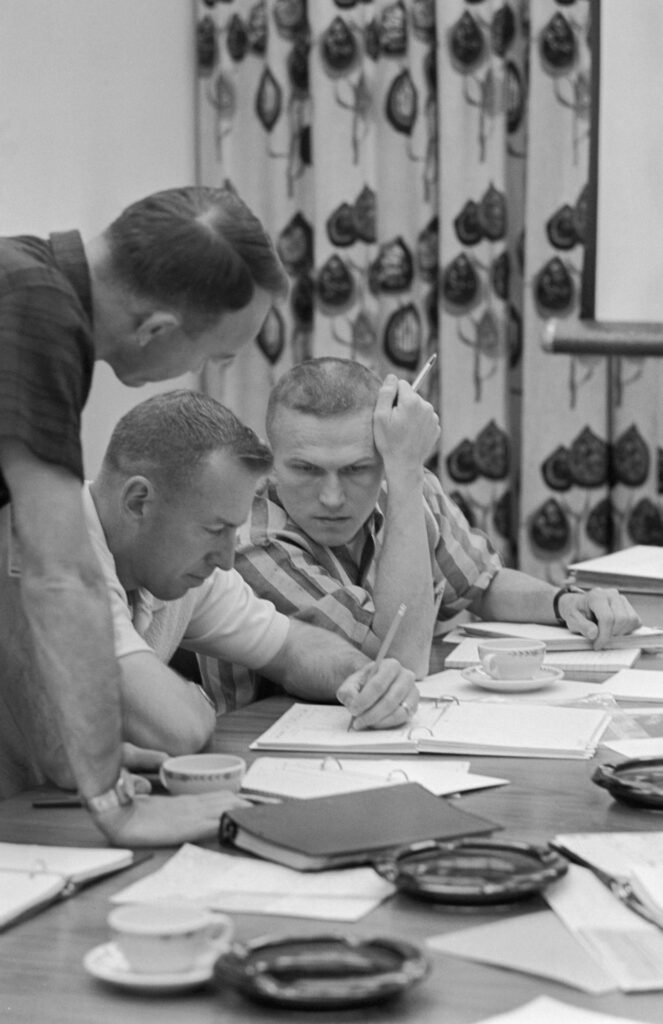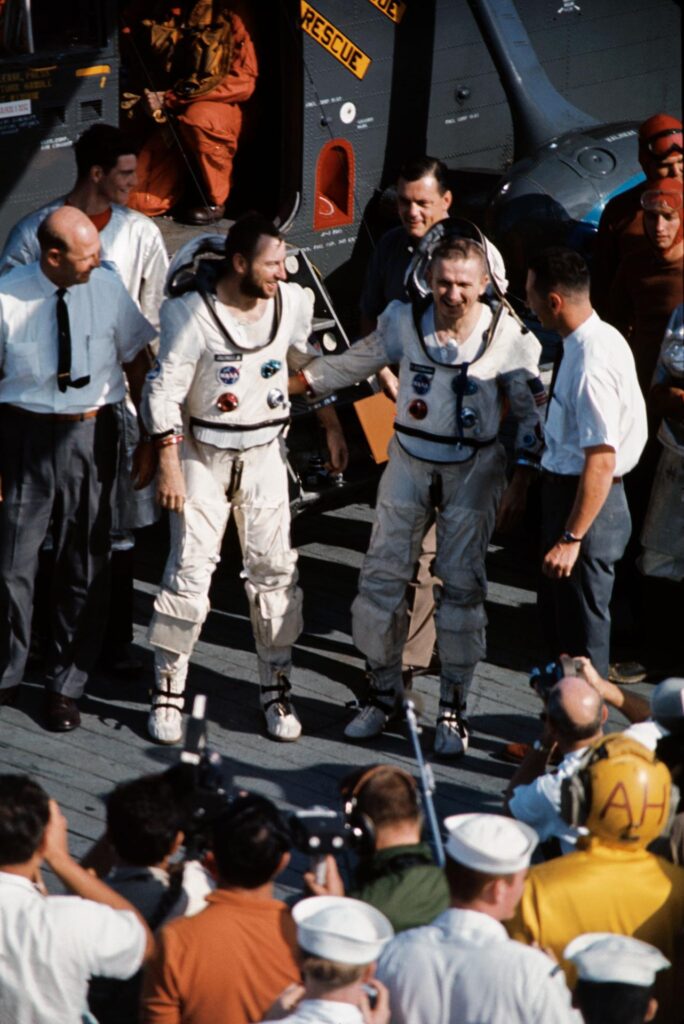Astronaut Borman Died November 7, 2023

(Alamogordo, New Mexico) – Veteran of Gemini 7 and Apollo 8, Frank Borman passed away on November 7, 2023, in Billings, Montana, following a stroke. Borman was NASA’s oldest living astronaut. The New Mexico Museum of Space History extends its deepest condolences to Mr. Borman’s family and friends.
Frank Borman II was born in Gary, Indiana on March 14, 1928, but was raised in Tucson, Arizona. Fascinated by airplanes since he was five, Borman earned his pilot’s license at the age of fifteen. He graduated from Tucson High School in 1946 and received a Bachelor of Science degree from the U.S. Military Academy, West Point, in 1950, and a Master of Science degree in Aeronautical Engineering from the California Institute of Technology in 1957. He completed the Harvard Business School’s Advanced Management Program in 1970. After leaving West Point, Borman chose a career in the Air Force, earning his pilots’ wings in 1951. For the next five years, he served in fighter squadrons in the United States and the Philippines.
Borman became an assistant professor of thermodynamics and fluid mechanics at the United States Military Academy in 1957. In 1960, he graduated from the US Air Force Aerospace Research Pilots School then stayed on as an instructor until 1962, when he was selected by NASA to be an astronaut. From December 4 to 18, 1965 Frank Borman and James Lovell, Jr. spent a then-record fourteen days in orbit aboard Gemini VII. While they were in orbit, Gemini VI, with astronauts Wally Schirra and Tom Stafford, was launched. The two Gemini craft executed the first space rendezvous, their ships maneuvering to within one foot of one another on December 15. Gemini VII proved that astronauts could pilot their spacecraft to an orbital rendezvous and that humans could tolerate a two-week-long space mission. Both abilities were required for later Apollo lunar missions.

Apollo 8, the first crewed mission to use the mammoth Saturn V rocket, was launched on December 21, 1968. Its crew, Commander Frank Borman, Command Module Pilot James Lovell, and Lunar Module pilot William Anders became the first humans to travel to the Moon, though they did not land.
In “Genesis” (Four Wall Eight Windows/1998), author Robert Zimmerman describes the scene prior to liftoff: “Sealed within a cramped cone-shaped compartment about the size of a customized van, three men waited silently. They were perched three hundred sixty-three feet in the air. Below them pulsed 1,500 tons of powerful fuel, about to ignite in a fiery explosion.” The waiting was tense because, Zimmerman documents, the Saturn 5 rocket had been “tested only twice before, and never before used to put human beings in space.”
Once in orbit, Apollo 8 circled the Earth just three times before aiming toward the Moon.
“Apollo 8 was like no other space mission,” Zimmerman explains. “Of the (27) previous manned launches, both American and Soviet, none had ever ventured higher than 850 miles in altitude.”

On Dec. 24, Christmas Eve, as Apollo 8 flew 70 miles above the Moon, Anders took the color photograph known as “Earthrise.” Shortly before, Borman had snapped a picture of what Zimmerman says is the “first earthrise ever witnessed by humans.” Borman’s black-and-white photo shows Earth just clearing the horizon. Anders’ shows Earth several degrees over the lunar surface and has often been printed as the Earth rising above the edge of the Moon’s horizontal surface. Anders, though, is emphatic the Moon was vertical on the right.
The U.S. Postal Service issued the photograph on a six-cent stamp with the words, “In the beginning…” The phrase paid homage to the Christmas Eve TV broadcast of the crew reading from the biblical Genesis. Zimmerman states a reporter put the idea of a “Christmas-type gesture from space” into Borman’s head.
On Christmas Day, while the spacecraft was completing its tenth revolution of the moon, the service propulsion system engine was fired for more than three minutes, propelling Apollo 8 back toward the earth after more than twenty hours and eleven minutes in lunar orbit. The Apollo 8 Command Module splashed down in the Pacific on December 27, 147 hours after liftoff. All mission objectives and detailed test objectives were achieved, as well as five that were not originally planned. Frank Borman logged a total of 19 days, 21 hours and 35 minutes in space during his two missions.
After Apollo 8, Borman left NASA to serve as a Special Presidential Ambassador on trips throughout the Far East and Europe, including a 1970 worldwide tour to seek support for the release of American prisoners of war held by North Vietnam. He became a special advisor to Eastern Airlines in early 1969, and after retiring from the Air Force in 1970 (as a colonel) was named Senior Vice President of Eastern’s Operations Group. He was promoted to Executive Vice President-Genera Operations Manager and was elected to Eastern’s Board of Directors in July 1974. In May 1975, he was elected President and Chief Operating Officer. He was named Chief Executive Officer in December 1975 and became Chairman of the Board in December 1976.
Colonel Frank Borman retired from Eastern Airlines in June of 1986. He moved to Las Cruces, New Mexico, where he and his son ran a Ford dealership which they operated for several years. In 1998, they bought a ranch in Bighorn, Montana.
He has received the Harmon International Aviation Trophy, the Robert J. Collier Trophy, the Tony Jannus Award, and the National Geographic Society’s Hubbard Medal, in addition to many honorary degrees, special honors and service decorations. In 1978, he was one of the six original recipients of the Congressional Space Medal of Honor, for his role on Apollo 8.
Colonel Borman was inducted into the International Space Hall of Fame at the New Mexico Museum of Space History in 1982.
About the New Mexico Museum of Space History: www.nmspacemuseum.org
The New Mexico Museum of Space History in Alamogordo is a division of the New Mexico Department of Cultural Affairs. A Smithsonian Affiliate, the museum showcases the significant role New Mexico has played in the development of the U.S. Space Program and features the International Space Hall of Fame and New Horizons Dome Theater.
3198 State Route 2001 | Alamogordo, NM 88310, (575) 437-2840 for more information or visit the website at www.nmspacemuseum.org. Like us at: www.facebook.com/NMSpaceMuseum/
